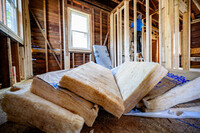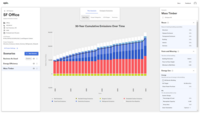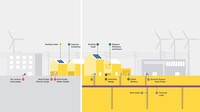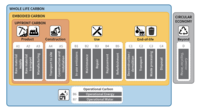BuildingGreen Report
Explainer
Most low-carbon strategies are complementary, but not always. When is a carbon savings worth a carbon penalty?
I could press the snooze button on my alarm and get a little more sleep. But, then I might be late to work again. A classic tradeoff.
As our tools become better at estimating carbon impacts, it has become clear that there are also tradeoffs between embodied carbon and operational carbon. Efforts to reduce one might increase the other.... Read more
News Analysis
The initiative offers a set of actions for the international building sector to collaborate on decarbonization and resilience
Ever wonder how the building sector is contributing to the goals of the Paris Agreement?
Look no further than the Buildings Breakthrough, an initiative to drive international collaboration to make near-zero-emission and resilient buildings the new normal by 2030. Launched at the 2023 U.N. Conference of the Parties (COP28), the Buildings... Read more
Op-Ed
In a letter to the editor, the Sustainable Forestry Initiative details eight objections to BuildingGreen’s evaluation of its programs.
After reviewing the BuildingGreen report: Wood Certification: Comparing Programs and Their Impacts, we note a strong bias in its tone, selective focus, blatant errors, and omission of critical facts. Overall, the report uses erroneous and ambiguous language to portray SFI inaccurately and negatively while presenting FSC in a disproportionately... Read more
News Brief
Three existing buildings: a retail space, an office skyscraper, and high-rise apartments achieved LEED certification under the new v5 rating system.
USGBC announced the first three projects certified under the new LEED v5 Operations & Maintenance (O+M) rating system, still in beta testing.
In LEED v5 O+M, USGBC has added prerequisites and credits focused on carbon, health, equity, and resilience. For instance, project teams are now required to assess a building’s resilience and... Read more
Product Review
The Greenbuild expo always showcases innovative products and industry trends. This year there were some significant seismic shifts in the green products displayed and the ideas presented.
When people think of the Greenbuild expo floor, their perceptions are not usually those of music, art, or beauty. But it is a bit of an art navigating schedules and meetings in order to see products and talk to manufacturers amongst the cacophony of the crowd, concrete floors, and cavernous space.
If art does reflect the times we live... Read more
News Brief
Building on the 2023 Portfolio Accelerator, PERFORM will formally verify portfolio-wide progress toward sustainability goals
High-performing, LEED-certified buildings are great for showing what’s possible, but the vast majority of existing building will never pursue—much less achieve—certification. But those buildings are responsible for the lion’s share of carbon emissions from the built environment, so it’s imperative to improve their performance.
At... Read more
News Brief
With independence, C.Scale aims to advance building decarbonization
Architecture firm EHDD announced on November 12 that it’s established a new company, C.Scale, as an independent public benefit corporation. Jack Rusk, EHDD’s former director of climate strategy, left the firm to become C.Scale’s CEO. And Brad Jacobson, FAIA, principal and partner at EHDD and co-founder of C.Scale, will join the C.Scale team... Read more
News Brief
With its Certified Circularity Standard, Cradle to Cradle hopes to expand the reach of its product circularity efforts
The Cradle to Cradle Products Innovation Institute (C2CPII) recently announced the release of a new certification option, the Certified Circularity Standard. Derived from the full standard, the new certification is “designed to provide an accessible pathway for companies of all sizes to create and verify circular products,” explained Ren... Read more
Op-Ed
BuildingGreen’s longtime friend and collaborator Ann Edminster shares her reflections on the lives of three green building pioneers.
The green building community suffered a tremendous threefold loss in October 2024 with the deaths of Matts Myhrman on October 15, David Goldstein on October 18, and Sim Van der Ryn on October 19. The departures of these three hit me particularly hard because all of them were important figures in my professional journey and green building... Read more
News Brief
Leading industry nonprofits have committed to supporting the Biden Administration’s definition of a zero-emissions building as they evolve their programs, including LEED v5, Living Building Challenge, and Passive House.
The federal government finalized its definition of a “zero-emissions building” in June of this year. Since then, major industry groups have formally announced their intentions to align with it.
The definition is not a standard, and the government doesn’t plan to adjudicate whether a particular project fits the definition, the Biden... Read more
News Analysis
A new California law will allow utilities to replace aging gas infrastructure with zero-emission alternatives in 30 pilot projects
The clean energy transition is upon us. But if we’re not proactive about making it equitable, many people—especially renters along with homeowners in disadvantaged communities—could be left behind paying ever-increasing gas prices.
With its newly passed Neighborhood Decarbonization Act (SB 1221), California seeks to demonstrate—through... Read more
Product Review
ClarkDietrich’s low-embodied-carbon cold-rolled steel products meet Build America, Buy America Act and Buy Clean Act federal purchasing requirements.
Steel is one of our most versatile and important building materials. It is found in even the most boutique low-embodied-carbon buildings. But steel is also one of the world’s biggest sources of carbon emissions, and production of raw steel can come at significant costs to local communities, especially in China where mills create poor air... Read more
News Analysis
A new Arup report demystifies the time value of carbon, why it matters, and why we need to be careful with it.
Are today’s carbon emissions worse than tomorrow’s?
Should embodied carbon be a higher priority than operational carbon?
Is temporary carbon storage beneficial?
These are daunting and complicated questions, which most project teams are probably not trying to answer directly. Still, building practitioners do often make... Read more
News Brief
Clean energy projects sparked job growth in 2023, growing the sector to nearly 3.5 million workers.
Clean energy jobs spiked in 2023, which according to the Clean Jobs America report from the nonpartisan business group E2, is partly attributable to the first full year of the Inflation Reduction Act (IRA). In 2023, alone, the clean energy economy grew by almost 150,000 jobs, a pace nearly two times faster than overall national job growth.... Read more
News Brief
Through unprecedented collaboration, building industry NGOs publish two reports to drive widespread project-level embodied carbon reporting at the project level.
Over the last few years, many different organizations have developed programs and processes to address embodied carbon of entire projects: buildings, site work, and infrastructure. But embodied carbon champions became concerned that divergent methods and assumptions would slow the adoption of project LCAs, as owners might hesitate to invest in... Read more
Product Review
The Ereasy system transforms hempcrete from a labor-intensive niche product into one that can be used in a number of applications.
Industrial hemp has amazing potential as a building material. It grows quickly on small plots. It is drought resistant. It can grow in poor soils, regenerating them by fixing nitrogen. And it has the potential to store a lot of carbon.
In the past, hemp was one of the world’s biggest crops, grown primarily for its fibers, which were... Read more
Webcast
In simpler times, our buildings were made primarily from local, natural substances like stone, wood, straw, and clay.
But lifestyles have changed dramatically since these were the dominant materials used. Now, although many communities are still following the “old ways,” in the richest parts of the globe, ultra-processed materials make... Read more
News Brief
EPA shares its plan for a low-embodied-carbon labeling program, funded by the Inflation Reduction Act.
Federally funded projects are responsible for as much as a third of all U.S. construction emissions, estimates the General Services Administration (GSA) Green Building Advisory Committee.
As one piece of a comprehensive strategy to reduce this impact, the Environmental Protection Agency (EPA) is creating a labeling program to drive... Read more
Product Guide
First and foremost, it is best to use native landscaping or xeriscaping that is drought-resistant and reduces or eliminates water, energy, and chemical use.
When irrigation is required, preference should be given to products labeled by EPA’s WaterSense program. WaterSense-labeled products undergo rigorous testing to ensure they are at... Read more
Spotlight Report
Our buildings used to be made from local, natural materials. With no petrochemicals, these natural materials had minimal carbon footprint and were healthier for people and the environment. The climate and environment are now in crisis, brought on partially by the building materials that have ushered in our era of skyscrapers and... Read more











